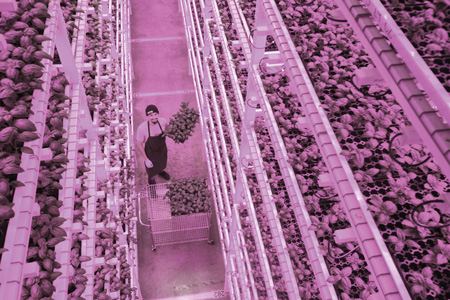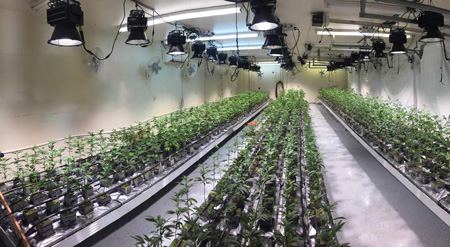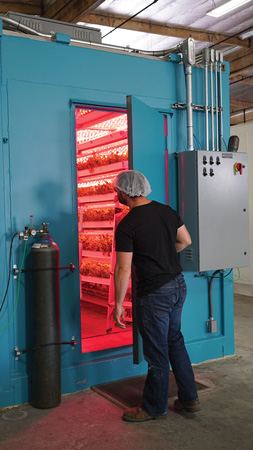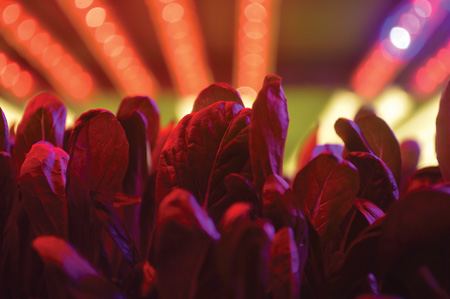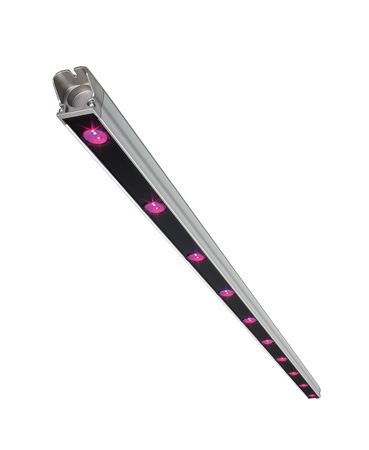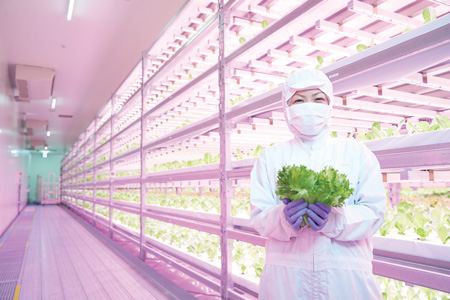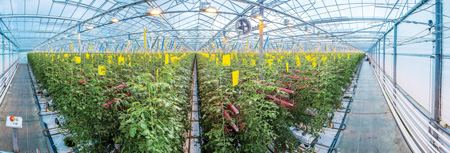Great article. After review of the information in this article be sure to follow the posted link at bottom of the page to visit LEDS magazine. Excellent resource for all things LED. White papers, studies, suppliers, mfgrs etc.
Published on:September 20, 2016
By Maury Wright
Editor in Chief, LEDs Magazine

LED-based SSL products are bringing revolutionary advancement to indoor and greenhouse growing operations, explains MAURY WRIGHT, but there remains much to be learned about the differing light needs of varying plant types and even how needs change during a growth cycle.
High-power LEDs are bringing similar revolutionary benefits in life-science applications such as horticulture that the solid-state lighting (SSL) sources are offering in the general illumination area -energy efficiency, low/no maintenance, spectral control, and beam control. But plants need different things from light relative to people, and human-oriented metrics such as efficacy (lumens per watt - lm/W) or CRI may or may not provide any indication as to whether an LED luminaire will deliver results for vegetable and flower growers. Moreover, plants have circadian cycles that differ from those of humans and that vary widely from plant species to species. Still, growers are quickly moving to SSL in greenhouses and especially in indoor urban or vertical farms while the horticultural community is working overtime to decipher the needs of plants in terms of light recipes for optimal growth and yield.
FIG. 1. Green Sense Farms grows micro greens, lettuces, baby greens such as kale and watercress, and herbs in a Chicago-area vertical farm that can deliver the fresh produce to buyers on the day of harvest.
SSL could truly revolutionize the global horticulture industry including edible produce and the similar floriculture or flower-centric industry. LED-based lighting will also play a critical role in cannabis growing, especially as the legal climate evolves for both medical and/or recreational marijuana usage. Indeed, the growing significance of LEDs in horticulture led us to plan our inaugural LEDs Magazine Horticultural Lighting Conference slated for Oct. 12; further details can be found below.
SSL roles in horticulture
The use case for LEDs in fruit and vegetable farming centers around extending the growing season, especially in cold regions with short summers. Artificial lighting, primarily high-pressure sodium (HPS) lighting in the past, has long been used in greenhouses to extend tomato seasons, for example. We will discuss what LED lighting adds to the story throughout this article, but one clear advantage of SSL is the fact that the lighting produces no heat and growers can use interlighting - placing lights near/between the plants, run either vertically or horizontally to deliver light to the lower foliage that doesn't receive much direct light from above as the plant grows.
The greenhouse use case for LEDs is primarily as a supplementary light source to the sun, although the artificial lighting is increasingly vital during the colder and shorter days of winter. Cannabis also requires greenhouse-like space where plants can grow vertically. But most legal cannabis growing operations are for now indoors, and require electrical fixtures as the primary light source.
Where LEDs are having the greatest impact, however, is in growing leafy greens and herbs that only reach heights measured in inches and that can be grown in layers or racks with each layer having a dedicated set of LED luminaires relatively close to the plants, again enabled by little to no heat radiated by the LEDs. The layering enables so-called urban or vertical farms to occupy relatively small growing spaces inside buildings near population centers, while optimal lighting and technology including hydroponics enables much faster plant/harvest cycles than can be achieved outdoors.
The range and scale of such operations is amazing. Our cover photo for this issue shows a Local Roots vertical farm housed in a used shipping container. The company is a Los Angeles, CA-based grower of leafy greens and herbs. Fig. 1, meanwhile, depicts an industrial-building-scale vertical farm operated by Green Sense Farms in Indiana, a short drive from the Chicago, IL metro area.
FIG. 2. Spectrum King LED luminaires use predominantly white LEDs and are regularly sold into legalized medicinal or recreational cannabis growing operations indoors.
Urban farms
Indeed, it is perhaps the urban farms where LED lighting may have the largest impact on horticulture, and it wouldn't be a huge stretch to say that impact extends to global society and the environment. The ability of growers to operate in high-volume vertical farms in any city means that the transportation cost will be slashed relative to the cost associated with farming in remote areas such as California's Central Valley. Consumers will get access to produce in some cases the day it's harvested and the product will have a far greater shelf life. And there will be immeasurable reductions in the carbon footprint associated with farming, both due to short transport and elimination of carbon-producing outdoor machinery needed for traditional farming.
The benefits of LED horticulture to the consumer run deeper - and tastier. We will discuss later the qualitative opinion of many that produce grown under LED lighting tastes better. That may be a judgment call, but fresher produce almost always tastes better. Furthermore, urban farms provide consumer access to micro greens and herbs that just might not be available otherwise. Green Sense, for example, grows plants such as baby kale, watercress, arugula, and more along with herbs like basil and thyme. The urban farms also are generally pesticide free and the yield may not even require washing given that it's often grown hydroponically in clean media and not dirt.
The growing methodology is extremely water efficient, and that's a major issue in regions such as California where the farming-centric Central Valley is relatively close to Los Angeles and San Francisco, but the state is in a persistent drought. In other areas globally such as China, the groundwater and/or soil is polluted and there is little other way to produce safe and tasty produce.
FIG. 3. Local Roots constantly adapts its LED lighting in shipping-container-based farms for optimum production of leafy greens.
Challenges in horticultural lighting
There are, of course, challenges in any emerging technology and perhaps even more so in LED-based horticultural lighting where experience with SSL technology is still shallow, and even the long-involved horticultural scientists are still developing research on light recipes for plants - and some of those new recipes weren't feasible prior to LED sources with controlled spectrum entering the picture.
Lighting manufacturers based in Asia have targeted the market with what are often affordable but low-end products, but many of the low-end products on the market lack pertinent certifications such as UL ratings, as well as LM-79 reports for fixtures and LM-80 reports for the LEDs used in the fixtures, said Rami Vardi, CEO of Canoga Park, CA-based lighting manufacturer Spectrum King. Vardi said many growers, especially in the cannabis sector, have been burned with early attempts to deploy LED lighting due to poor fixture performance and that HPS remains the gold standard for that industry.
Certainly, there are many high-quality lighting products on the market as well, including those from stalwarts such as Philips Lighting, Osram, and Hubbell Lighting. Both Osram and Philips have spent years on horticultural research working with university and dedicated-research-organization teams.
FIG. 4. AeroFarms in the New York area uses an aeroponic methodology to grow leafy greens in which the roots are exposed to only a mist for even more-water-efficient farming than hydroponics.
Still, the growers across the horticulture and floriculture space need both better metrics that are pertinent to the application and access to data on light recipes. As we covered in an article last year, the American Society of Agricultural and Biological Engineers (ASABE) Agricultural Lighting Committee began in 2015 to work on the standardized metrics issue. The work is considering metrics related to the PAR (Photosynthetically Active Radiation) spectrum among others. The PAR range is generally defined as the 400-700-nm spectral band where photons actively drive photosynthesis. Common metrics related to PAR include Photosynthetic Photon Flux (PPF) measured in micromoles per second (μmoles/sec) and Photosynthetic Photon Flux Density (PPFD) measured in μmoles/m2/sec where a mole can be directly converted mathematically to photons.
Recipes and metrics
Let's consider the inherently-intertwined issues of recipes and metrics because growers clearly need metrics that can discern whether a luminaire delivers the intensity and spectral power distribution (SPD) mix that comprises a recipe to optimize yield.
When we covered LED lighting in horticulture back in 2011, the key message was centered on research that documented chlorophyll absorption relative to spectral power because chlorophyll is key to the photosynthesis process. Laboratory research had indicated that energy peaks in the blue and red spectrum matched absorption peaks, whereas green energy was shown not to impact absorption.
That early research resulted in the plethora of fixtures on the market that emit pink or purplish light based on the use of monochromatic red and blue LEDs. The pervasive theory behind those products centered on energy efficiency and this question: Why should luminaire designs generate energy outside those bands if that energy would simply be wasted on the plant?
Current thinking, however, centers on lighting that can deliver peak energy in the blue and red spectrum but that also delivers a broad spectrum much like sunlight. Paul Scheidt, LED product development leader at Cree, said, "The industry seems to be moving more to white light."
FIG. 5. The Philips Lighting GreenPower LED Production Module includes a mix of red, far-red, blue, and white LEDs to dynamically deliver what the company said are the primary colors for plants.
White light matters
Others have made more forceful statements. Neil Yorio, vice president of Biological Innovation and Optimization Systems (BIOS), commented on the topic; his company is working on LED luminaires for cannabis and other sectors. "The use of only red and blue LEDs is pretty outdated, and when you see products with that spectrum, it is based on older science and is frequently misinterpreted," said Yorio. "The reason people have chosen blue and red is because these wavelength peaks align with the absorption profile of chlorophyll a and b isolated in test tubes. That is not what is happening in intact leaves. We know today that all wavelengths of light in the PAR range are useful in driving photosynthesis. No doubt spectrum has importance, but it is associated with plant morphology such as size and shape rather than growth and yield or biomass."
Yorio's point is that research shows we can impact plant height and flowering by changing the spectrum. And as we will discuss a bit later, some growers continuously modulate light intensity and SPD mix to plants as the plants do have something akin to a circadian rhythm, although most every plant species has a unique rhythm and recipe requirement for optimal yield.
Vardi of Spectrum King said the predominant red and blue mix might work relatively well for leafy greens such as lettuces. But he also said flowering plants where biomass is the goal, including tomatoes and cannabis among others, require intensity more than specialized spectrum. Vardi said 90% of the energy in HPS lights is in the yellow region, and that lumens (lm), lux (lx) and efficacy may be more accurate than PAR-centric metrics in horticultural luminaires for flowering plants. Spectrum King uses 90% phosphor-converted white LEDs in its luminaires with the remainder being red or far-red LEDs. Vardi said the blue emitters that are the basis for white LEDs deliver all of the blue energy required for optimal production. The products depicted in Fig. 2 are in the traditional form factor of an HPS lamp.
Even in vertical farms where the focus is products like lettuce, it appears that some white light is a requisite, although you can see via photos in this article that the bulk of the LED light produced remains pink to purple in nature. Robert Colangelo, founder and CEO of Green Sense Farms, will not share details of his company's light recipes as the recipes are considered key intellectual property (IP) for the business operation. But he said the farm has used various mixes of red, blue, and white light in growing lettuce, micro greens, baby greens, and herbs. Green Sense has been described in some mainstream media articles as the largest indoor commercial grower. Colangelo said it's difficult to quantify scale, but the company's first farm in Indiana has 8000 4-ft linear LED fixtures and the latest farm in China has 3500 8-ft fixtures.
Recipes and impact
White light can be important for reasons beyond baseline production in leafy greens. Several people we interviewed for this article said lettuce may not mature to look green without some light from the green spectral band. On the other hand, sometimes growers may control the spectrum to create new colors in produce. Gus van der Feltz, global director of city farming at Philips Lighting, for example, said you may want to grow a specialty lettuce with a red coloration. Also, white light is required at times for workers as we mentioned in a prior horticultural lighting feature, and as stated earlier the blue energy peak in white LEDs is a plus.
FIG. 6. The Innovatus farm located in the Fuji area of Japan produces 12,000 heads of lettuce each day.
Clearly, there is no consensus on light recipes, and researchers and growers are constantly striving to advance the science. Colangelo said, "We do constant research on light recipe per cultivar." Philips' van der Feltz said the recipe invariably must be different for each plant but added, "You can modulate the growth process." The point is that changing the light during the growth stages can make significant differences in the same species. In the article referenced just above, we covered some research on using far-red spectrum to impact flowering, for instance. Matt Vail, co-founder and COO of Local Roots, said, "We change the light on an hourly basis." Fig. 3 shows a Local Roots container with LED lighting evident through the doorway.
The recipe-development process is painstaking. Philips' van der Feltz said the company's research team investigated a single variety of strawberries over nearly a year, using different mixes of red, far-red, blue, and white light. But through that lengthy endeavor, ultimately the team found a recipe that delivered a 20% difference in better taste and juiciness.
What growers want
As the commercial LED-lit horticultural installations mature, there will be more certainty about what growers want from SSL manufacturers, although today that topic remains a bit of a mystery. Robert Colangelo from Green Sense identified four key things. First, Colangelo wants quality products that maximize the ratio of dollar per joule (a unit of energy or work done) per μmole. Second, he wants a lighting product that enables the farm to use a different light mix for each cultivar. Colangelo said Green Sense has not found a benefit to dynamically changing the lighting during the growth cycle but needs a different recipe for each species. Third, he cited ease of installation and noted that the company has moved to 8-ft luminaires from 4-ft luminaires because installation effort is essentially cut in half relative to the area covered. Fourth, Colangelo cited affordability and financing as important because he said lights are the most expensive element in a vertical farm.
Not all commercial growers have found what they need from commercial LED lighting manufacturers. Local Roots, for example, has designed and begun to manufacture a custom LED luminaire in a rectangular form factor for its operations. The company is equipping its used shipping containers to house a complete farm with one container having the ability to produce the equivalent of what a 5-acre traditional farm would produce. Local Roots powers its luminaires with DC, relying on a single AC circuit to the container. Vail said the design mixes monochromatic and white LEDs, and the customized control system can enable 0-100% control of the intensity of each LED. As we have covered in articles on DC power distribution, the architecture should also deliver additional energy efficiency relative to powering each fixture with AC.
FIG. 7. A French tomato farm uses Philips fixtures for interlighting between rows of plants to deliver needed spectral energy to the lower foliage of each plant.
Of course, all of the urban farmers we interviewed stressed that the horticultural problem requires a system-level approach that goes beyond lighting. These large urban farms typically implement complete environmental control with computers measuring things like temperature and humidity, and controlling hydroponic feeding along with the lights.
Moreover, the operations develop partnerships that are often governed by IP protections. Green Sense, for instance, uses a unique growing medium fashioned from coconut husks. A New York area farm called AeroFarms (Fig. 4) created a custom substrate or growing cloth medium made from recycled water bottles. And AeroFarms uses what it calls an aeroponic system that sprays mist on the roots, which the company said uses 40% less water than do hydroponic systems.
LEDs enable vertical farming
Still, it's the LED technology that has truly made vertical farming pay off. Colangelo of Green Sense said LED lights enabled the vertical concept to go from pilot to commercial. He said growers could go from seven to eight layers with linear fluorescent lighting to 12 to 14 layers with LEDs in a building with, say, 25-ft-high ceilings. LED efficiency and the lack of radiated heat were the key enablers.
The lighting and LED manufacturers, meanwhile, are working diligently to deliver products that enable growers to succeed. Cree, for example, recently announced what it called a Photo Red LED in the far-red spectrum that might be useful in encouraging flowering. Spectrum King is apparently using that LED in its fixtures.
Philips Lighting recently announced what it calls the GreenPower LED Production Module which, despite the name implying a module, is a finished linear fixture that has been added to the GreenPower family of products. The new product (Fig. 5) integrates a mix of red, far-red, blue, and white LEDs and comes with software for programming light recipes. "Red, blue, white, and far red are the primary colors for a plant," said van der Feltz. And the new luminaire can mix those colors just like an RGB fixture delivers a full spectrum for the human eye.
The GreenPower LED Production Module is intended both for growers to work on light recipes and for growers to use in commercial farms when dynamic lighting is deemed beneficial. For example, Philips just announced two major urban farms in Japan that are using the new luminaire. The Innovatus farm in the Fuji area is producing 12,000 heads of lettuce each day using the fixtures (Fig. 6). But van der Feltz also said other growers might use the tunable product to develop optimum recipes and then deploy a mix of fixtures in fixed colors in a commercial farm.
Osram also announced a new set of horticultural fixtures in its Zelion family recently. The series includes spectrum-tunable models focused on delivering PAR light. Those Osram products also include PC software to control the fixture output.
Horticultural revolution
Ultimately, LED lighting is poised to revolutionize all types of horticulture. Consider tomatoes. In one of the earlier linked feature articles, we cover a North Carolina tomato farmer called Patterson Greenhouses that was able to significantly extend the growing season even in a relatively warm region of the globe. We also covered a Philips Lighting tomato project in France where the fruit is apparently tastier under LEDs (Fig. 7). That project used the aforementioned interlighting with LED luminaires from Philips that you can see in the photo running horizontally between plants.
Of course, taste will always be a qualitative issue. The Stockbridge Technology Centre in the UK is an industry- and government- funded research organization working in horticulture and has done significant tomato research. Applied photobiologist Phillip Davis discussed the organization's work with tomatoes and said they tested tomatoes in four lighting scenarios - HPS lighting from above, HPS from above with LED interlighting, LED from above, and LED from above with LED interlighting. Davis said yields were similar but that test subjects preferred the tomatoes exposed to interlighting in both cases.
Indeed, interlighting can change the way tomatoes are grown. Stockbridge lets the plant grow to heights not typically practical for maintenance, harvesting, or lighting. But interlighting continues to supply energy to the lower foliage and harvesting occurs invariably in the lower portion of the plant. As a 1-2-ft section of the plant exhausts its productivity, the Stockbridge team lowers the plant that is tethered vertically such that the fallow stalk is parallel to the ground but still supplying nutrients to the rest of the plant, bringing the next section of the plant into easily harvestable reach. The technique produces tasty fruit and extends the productive life of the plant.
The impact of LEDs will still likely be of a larger magnitude in vertical farms, and will change completely the way farmers do business. Green Sense, for example, doesn't plant a head of lettuce or a basil plant until it has an order for that plant and a promised delivery date. The precisely-controlled growing environment delivers very predictable growth cycles that are double or more the frequency of outdoor cycles. Colangelo said micro greens require 8-10 days while lettuce requires 35-40 days. Green Sense contracts with buyers for its total production in advance. About the model, Colangelo said, "It takes market risk out of farming."
Green Sense has a global vision for its business, thus its recent opening of a farm in China. Colangelo said the company would look to expand in any region where the economy will sustain a demand for a premium product and where either growing seasons are short or land and water resources are constrained. He said the Chinese population is increasingly demanding better quality products including food, and pollution in both water and land resources limits growing space, making vertical farming a great match. Colangelo has a number of other farms in the planning stage with the next up for commercial operation being another Indiana operation in conjunction with the Ivy Tech Community College in South Bend, IN.
Local Roots, meanwhile, has a different plan to serve the global market. Vail said the company's mission is "better food for the people and better practices for the environment." That mission runs through the choice of shipping containers as a growing vessel that might otherwise be thrown away to enabling urban operation near population centers. The company literally operates in the heart of downtown Los Angeles and supplies restaurants and farmers' markets in the area with just-harvested greens and herbs.
But Local Roots has a different vision for going global. The company may itself expand operations and Vail said, "We will always be farmers growing food." But the company is now moving toward selling a fully functional farm to other growers. Local Roots would completely equip a shipping container including with its own IP in light recipes and software controls, and ship the container to select growing operations. Vail said it would really be selling a farming business as opposed to selling equipment.
Of course, the question remains as to why ship an extremely heavy container pre-equipped with LED lighting, drivers, pumps, computers, and more as opposed to just supplying the equipment. Vail said it goes to repeatability and the proven form factor along with Local Roots' ability to assist potential customers with what is a precisely known environment. Vail said the company has yet to sell such a farm but has had hundreds of growers approach them on the topic and is active in discussions with dozens of groups.
Without question, LED lighting is not for every type of horticulture. It would be hard to imagine anything replacing Vidalia onions grown in a specific type of soil in southeastern Georgia, or watermelons from Texas, and more. But if LEDs can enable tasty tomatoes year round, and enable access to pesticide-free greens that don't even need to be washed, such a scenario would be a great step forward.
There are, of course, other issues to be solved. Fungus can be an issue indoors with no UV exposure. Plant circadian rhythm is still not well known. But new LED technology could come to play in those areas also. Indeed, that topic will be the focus of the Closing Plenary at our aforementioned Horticultural Lighting Conference, based on research done by Jaimin Patel and Mark Rea of the Lighting Research Center at Rensselaer Polytechnic Institute, and David Gadoury of Cornell University.
 eyehortilux.com
eyehortilux.com




